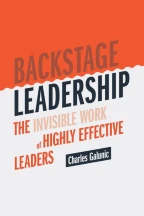
There is a political process to building authentic commitments to strategic directions. Executives must be able to get employees to collectively agree upon both “making” and then “taking” strategic decisions which everyone feels good about. Leaders first determine where on a democratic to autocratic spectrum commitment processes lie within their organization, what is the right mode given the context. Then they can use two approaches to achieve commitments: “Creative Fair Process” and “Mobilization.” Creative Fair Process is more democratic and is about “pulling in” people in order to reach a decision. It is best implemented when there is relatively more ambiguity about a strategic direction and leaders need to keep the process as open as possible, without dragging the organization further behind the pace of industry. In contrast, mobilization is a more top-heavy method, pushing but also selling a direction, and more appropriate when a strategic direction is more or less “clear.” Key to both is the ability to move seamlessly between the foreground and the background in leadership work.
This is a preview of subscription content, log in via an institution to check access.
eBook EUR 32.09 Price includes VAT (France)
Hardcover Book EUR 40.08 Price includes VAT (France)
Tax calculation will be finalised at checkout
Purchases are for personal use only
Lam, Brian. (2006). “The Pope Says Worship Not False iDols: Save Us, Oh True Jesus Phone.” Gizmodo, December 26. Retrieved December 10, 2019. http://gizmodo.com/224143/the-pope-says-worship-not-false-idols-save-us-oh-true-jesus-phone.
McNish, J. and S. Silcoff. (2015). Losing the Signal: The Untold Story Behind the Extraordinary Rise and Spectacular Fall of Blackberry, p. 133. New York, NY, Random House, Business and Economics.
Idid., Chapter 10: The Jesus Phone, pp. 130–138.Fry, Stephen. (2008). “Gee, One Bold Storm Coming Up….” StephenFry.com, December 11. Retrieved December 10, 2019. http://www.stephenfry.com/2008/12/11/gee-one-bold-storm-coming-up/.
McNish, J. and S. Silcoff. (2015). Losing the Signal: The Untold Story Behind the Extraordinary Rise and Spectacular Fall of Blackberry, p. 171. New York, NY, Random House, Business and Economics.
Ibid., p. 221.Bunderson, J. S. and R. E. Reagans. (2011). “Power, Status, and Learning in Organizations.” Organization Science 22(5): 1183.
Smith, Andrew. (2017). “Who Is Elon Musk? Tech Billionaire, SpaceX Cowboy, Tesla Pioneer—And Real Life Iron Man.” The Telegraph, May 24. Retrieved December 10, 2019. https://www.telegraph.co.uk/technology/0/elon-musk-tech-billionaire-spacex-cowboy-real-life-iron-man/.
Vance, Ashlee. (2015). “The True Story of Elon Musk, Robert Downey Jr. and Tony Stark.” Linkedin, June 19. Retrieved December 10, 2019. https://www.linkedin.com/pulse/true-story-elon-musk-robert-downey-jr-tony-stark-ashlee-vance.
Rawls, John. (1971). A Theory of Justice. Oxford, Oxford University Press.The Fair Process Leadership Model can be found in the following citations, great additional material for learning about this approach, especially in the work of Prof. Ludo Van der Heyden. My approach here is to focus relatively more on the creative aspects: Van der Heyden, Ludu, Christine Blondel and Randel S. Carlock. (2005). “Fair Process: Striving for Justice in the Family Firm.” Family Business Review XVIII; Van der Heyden, L. and T. Limberg. (2007). “Why Fairness Matters.” Springer International Commerce Review 7(2); Kim, W. C. and R. A. Mauborgne. (1998, April). “Procedural Justice, Strategic Decision Making, and the Knowledge Economy.” Strategic Management Journal (Special Issue) 19(4): 323–338.
Bilderbeek, Pam. (2015). “How Apple, Cisco and Huawei Disrupted the Telecom Equipment Market.” The Metis Files: Source to Success, April 15. Retrieved December 10, 2019. https://www.themetisfiles.com/2015/04/how-apple-cisco-and-huawei-disrupted-the-telecom-equipment-market/.
Galunic, Charles, Javier Gimeno and Lisa Duke. (2016). “Alcatel, Lucent…Nokia: On the Road from 3 to 1: The Leadership Challenges of Strategic Change.” INSEAD Case Study, February 24, p. 13.
Thomsen, Dave. (2012). “Why Human-Centered Design Matters.” Wired, December. Retrieved August 27, 2019. https://www.wired.com/insights/2013/12/human-centered-design-matters/.
IDEO. (2012). “Putting a Human Face on Big Data”. Retrieved December 10, 2019. https://www.IDEO.com/case-study/putting-a-human-face-on-big-data.
Edmondson, Amy. (1999, June 1). “Psychological Safety and Learning Behavior in Work Teams.” Administrative Science Quarterly 44(2): 350–383.
Kenny, Brian. (2014). “Collective Genius.” HBR Newsroom, September 12. Retrieved August 27, 2019. https://www.hbs.edu/news/articles/Pages/linda-hill-collective-genius.aspx; Swetzoff, Jen. (2015). “Linda A. Hill on the Creative Power of the Many.” Strategy + Business, March 16. Retrieved August 28, 2019. https://www.strategy-business.com/article/00315?gko=f6c22.
Vuori, Timo and Quy Huy. (2015). “Structures of Attention and Shared Emotion in the Innovation Process: How Nokia Lost the Smartphone Battle.” Administrative Science Quarterly, 1–43.
Galunic, Charles and Jacques Neatby. (2013). “Order in the Strategy Court.” Harvard Business Review, November 26. Retrieved December 10, 2019. https://hbr.org/2013/11/order-in-the-strategy-court.
Casciaro, Tiziano, Amy C. Edmundson and Sujin Jang. (2019). “Cross-Silo Leadership.” Harvard Business Review, May–June. [TK] Retrieved August 28, 2019. https://hbr.org/2019/05/cross-silo-leadership.
Clayton, Sarah. (2015). “Change Management Meets Social Media,” Harvard Business Review, November 10. Retrieved August 23, 2019. https://hbr.org/2015/11/change-management-meets-social-media.
Galunic, Charles, Javier Gimeno and Lisa Duke. (2016). “Alcatel, Lucent…Nokia: On the Road from 3 to 1: The Leadership Challenges of Strategic Change.” INSEAD Case Study, February 24, p. 13.
Galunic, C. and I. Hermreck. (2012). “How to Help Employees ‘Get’ Strategy.” Harvard Business Review, December, p. 24. Retrieved December 10, 2019. (Research Briefs). https://hbr.org/2012/12/how-to-help-employees-get-strategy.
See in particular the large body of work by Jeffrey Pfeffer, on working with power in business organizations.
Burt, Ronald. (1992). Structural Holes. Cambridge, MA, Harvard University Press.Burt, Ronald. (2004). “Structural Holes and Good Ideas.” American Journal of Sociology 2(110): 349–399.
Killing, Peter. (2003). “Nestle’s Globe Programme: Globe Day Case C.” IMD Case Study.